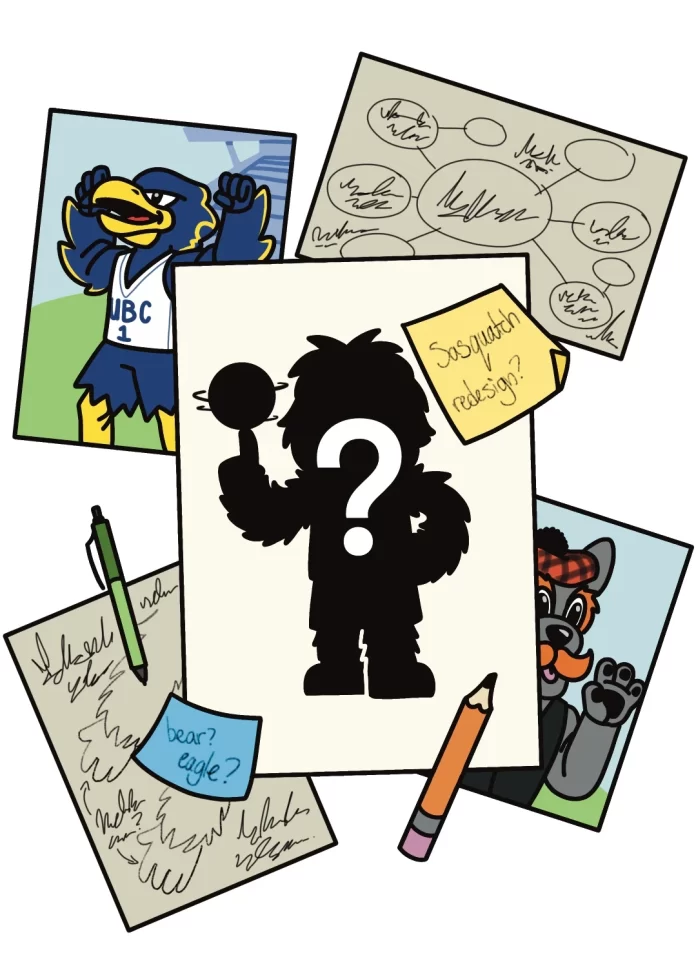Mascots are thought to bring luck for their respective teams — as the term mascot derives from the french word mascotte, which refers to a good luck charm. They are a popular way that sports teams establish a recognizable personality. Mascots are the embodiment of the distinct characteristics that define an organization, such as a university or college, and bring those qualities to life through character.
There are a few official mascots at universities in Greater Vancouver. By discussing their impact and importance we might glean what a successful mascot could be for UFV’s Cascades…. Oh wait, were you not aware of the UFV mascot, Sasq’ets?
At the University of British Columbia we have the Thunderbirds, whose mascot is the mythical bird of the same name. Their name was chosen via student poll in 1933, as it was felt that the Thunderbirds successfully symbolized the team’s fighting spirit and power.
One of many of Simon Fraser University’s Red Leafs’ mascots was that of a Scottish Terrier named McFogg the Dog, which embodied SFU’s Scottish heritage. The mascot’s design was made to be child and family friendly, which led it to become unpopular among students who felt the mascot was simply not intimidating enough. Drawing inspiration from cultural heritage is not inherently bad for a mascot’s design — it can be a great choice when executed correctly. UBC’s Thunderbird is an important figure in Northwest Indigenous culture.
The students have a point — sports mascots are commonly predator animals or a character with warrior traits, which often are associated with competitiveness. A common theme present in both examples is the acknowledgement and integration of the universities’ unique cultural context. Both Thunderbird and McFogg the Dog have mascot traits that directly reference the cultural heritage present in their respective universities.
What sets them apart, however, is the way through which they embody said traits and apply them in the context of competitive sports. UBC’s mascot succeeds at representing their team’s fighting spirit, competitiveness, and power, whereas McFogg the Dog did not represent SFU’s competitive traits. It stands to reason that an effective mascot for UFV’s Cascades would have to successfully convey the team’s qualities, as well as acknowledge and represent the university’s cultural context.
The last sports mascot UFV had was named Sasq’ets the Sasquatch, which has not had a social media presence since late 2018. The sasquatch is a large, long-haired bipedal mythical creature believed by the Indigenous to live in native forests in North America. Sasq’ets’ name and design as a sasquatch directly acknowledges the university’s cultural heritage and references a story from the Stó:l? peoples, whose land our university operates on. The story speaks of elderly people that were helped by a well-intentioned sasquatch, who brought firewood to keep warm, and deer so they could be fed. This led them to believe not all sasquatches were bad, and were thankful to be helped by one.
Mascots are a great way for a university to showcase what their sports teams are all about, and they bring entertainment and ambience for the cheering crowd. There are countless teams and organizations with mascots that have a strong presence, so why not have one ourselves? Perhaps UFV’s mascot could benefit from a redesign that would allow it to embody the competitive qualities of the Cascades, such as determination, unison, and perseverance. It would be incredible to see a revamped version of Sasq’ets that feels more intimidating, buff, cool and charismatic — like someone you wouldn’t want to mess with but would love to have as a friend.
Ultimately, a good mascot for a sports team should be able to uplift the spirits of the playing team members and the audience rooting for them. Designing a mascot that connects with the students and embodies the values of the university is key to creating the ideal mascot that UFV deserves.


